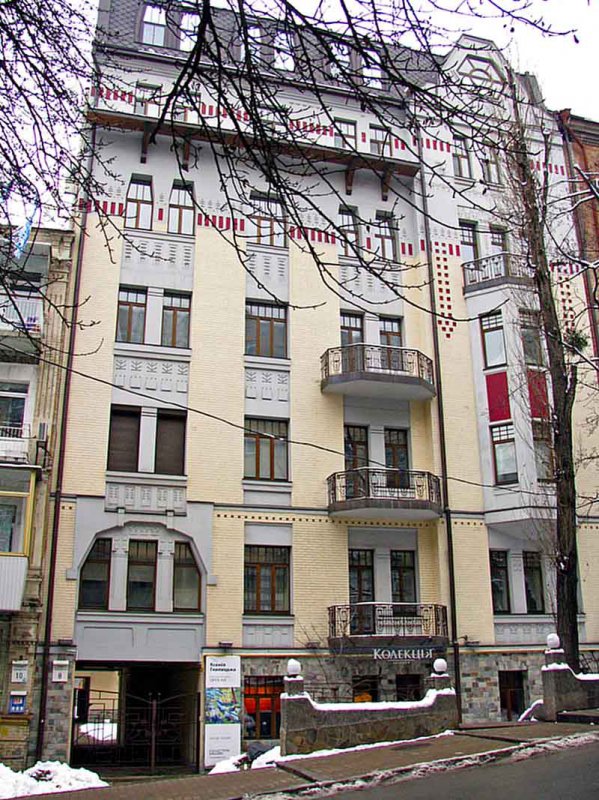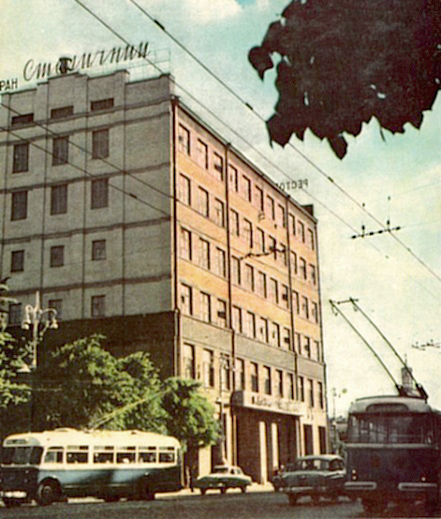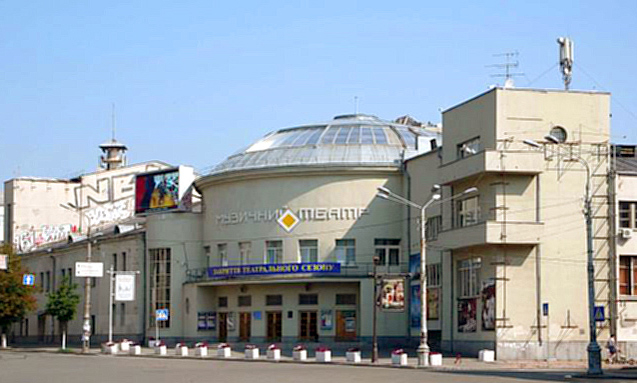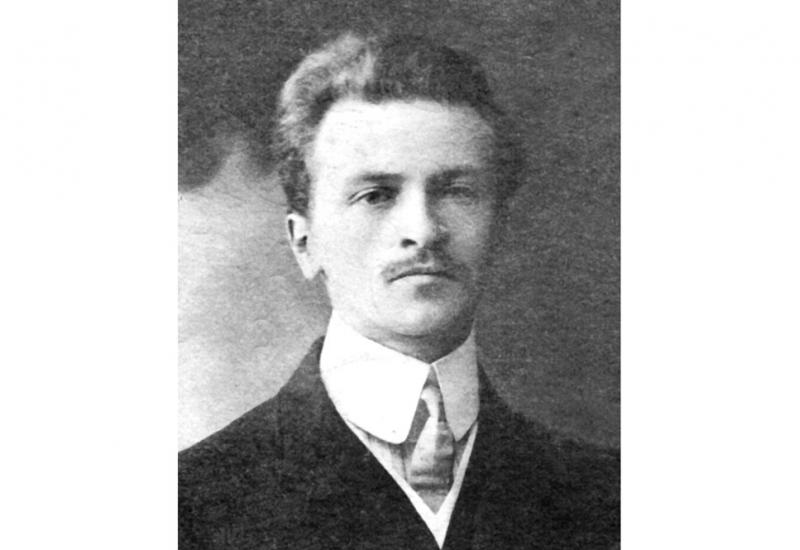Last summer marked the 50th anniversary of the death of the extremely interesting architect and artist Mykola Shehonin. Nobody noticed these anniversaries. And once he was a very famous architect in Kyiv and built several landmarks for the Ukrainian capital. And he was directly related to the Igor Sikorsky Kyiv Polytechnic Institute. For some reason, which will be discussed below, his name was hardly mentioned in our country, so now it is only returning to the public sphere.
However, before moving on to the story of him, let us recall that among the famous people who taught here at different times, a special place belonged to a cohort of prominent architects and artists. This is due to the fact that among the first four departments of the institute (ie, its faculties) was the engineering, which trained civil engineers, as then called engineers of buildings, and architects. Masters worked here from the first years of Kyiv Polytechnic formation and until its separation from the Kyiv Civil Engineering Institute in 1930 (now the Kyiv National University of Construction and Architecture) , many of whom are now recognized as classics of Ukrainian fine arts and architecture.
However, the name of Mykola Oleksiyovych Shehonin remains not very well known to the general public even today. At the same time, many of the buildings he designed still adorn our city and serve its inhabitants, and some of them are even considered architectural landmarks of the Ukrainian capital. In fact, the buildings he built can be seen not only in Kyiv, but the Kyiv period of his life was the most fruitful for him. Here he not only worked hard and with inspiration, but also started a family, here his only son Serhiy was born. So Kyiv became his second hometown after St. Petersburg, where he saw the world, and here he lived his happiest years.
Mykola Shehonin was born in 1882 in the family of a St. Petersburg merchant who was engaged in the flour-milling business. Apparently, the family did not suffer, so Mykola Oleksiyovych was educated at the Mykola I Institute of Civil Engineers, where he trained future civil engineers, many of whom worked as architects, and after graduating he visited Western Europe.
From 1907 Shehonin lived in Kyiv. At that time, a whole bunch of brilliant architects were actively working in the city. The city was actively built up, so such specialists were needed. Most of them were graduates of the Institute of Civil Engineers and the Imperial Academy of Arts. He was acquainted with some, and perhaps even befriended from St. Petersburg. Mykola Shehonin did not get lost in this circle: At the beginning of 1909 he took part in a competition for the design of the facades of the city public library (now the National Library of Ukraine named after Yaroslav the Wise) and his project, bypassing the works of more experienced masters, unexpectedly won first place. True, the city council preferred the more economical option proposed by architect Zbigniew Klyave, but the success of the young civil engineer from St. Petersburg did not go unnoticed.
One of its first buildings in Kyiv was a house at 101 Mariinsko-Blagovishchenska (now Saksaganskogo) Street, designed and built by order of engineer Stepan Lavrentyev in 1910. Until recently, the only author of this building was considered to be a civil engineer Serhiy Tymoshenko. However, the researcher of the life and creative heritage of Shehonin, the famous Kyiv scholar Dmytro Malakov in his book "Architect Shehonin. Three epochs "(Kyi Publishing House, 2017), based on documents, proved that Mykola Shehonin was the co-author of his project and a specialist who supervised the construction. He made several additions to the original design that made the house both more comfortable and more beautiful in appearance, changing some of the design solutions of the ground floor and decorating the facades with a number of decorative elements. This house was one of the first in Kyiv to be designed in the style of Ukrainian Art Nouveau. He, to some extent, determined the architectural face of two adjacent buildings, which were built at about the same time. However, the connection of this place with Ukrainian culture is deeper and is not limited to the design of facades and interiors of lobbies: a famous Ukrainian writer lived in the house of Lavrentyev in 1911 - 1913, folklorist and ethnographer, who wrote under the pseudonym Olena Pchilka - mother of Lesya Ukrainka Olga Petrivna Kosach. The great Ukrainian poetess often visited these place, as reported by a marble plaque. A prominent Ukrainian composer Mykola Lysenko and his son Ostap rented an apartment on the fourth floor of this house.

The figure of Shehonin's co-author Serhiy Prokopovych Tymoshenko is extremely interesting. Also a graduate of the Institute of Civil Engineers, he was not only a well-known architect who designed about 400 buildings in Ukraine, Georgia, Russia, Poland, Czechoslovakia, Canada, the United States and Paraguay, but also a well-known Ukrainian politician and public figure: during the Ukrainian Revolution - a member of the Central Council, Minister of Roads in several governments of the UPR, a participant in the Second Winter Campaign, in exile - an active member of the Ukrainian movement, professor, and in 1927 - 1928 even rector of the Ukrainian Academy of Economics in Podebrady (Czech Republic). a prisoner of Nazi concentration camps and a member of many Ukrainian diaspora organizations. And - the brother of the professor, head of the Department of Material Resistance and Dean of the Engineering Department of Kyiv Polytechnic Institute, later - one of the founders of the Ukrainian Academy of Sciences, a prominent Ukrainian-American mechanic Stepan Tymoshenko, whose monument now stands in front of the main building of Igor Sikorsky Kyiv Polytechnic Institute. ..

… In 1910, together with Serhiy Tymoshenko, Mykola Shehonin also built a house at Pankivska Street 8, better known as Yosyp Yurkevich's house. It was also built in the style of Ukrainian Art Nouveau. Every detail of its decoration (unfortunately, not all of them have survived to our time) bore the features of national tradition. This house is rightly considered one of the significant monuments of Ukrainian culture and history: at different times, the editorial offices of Ukrainian periodicals were located here, and among its inhabitants we find the names of the famous Ukrainian lexicographer, ethnographer, historian and writer Borys Hrinchenko and poets Mykola Voronyi and Maksym Rylskyi.
Then there were a few more residential buildings in Kiev: Banetska's house at Mariinsko-Blagovishchenska Street 78 with an outbuilding in the yard; Vladimirsky's house at the end of the same Mariinsko-Blagovishchenska (on the corner of this street and Bibikovsky Boulevard (now Taras Shevchenko Boulevard) - it was demolished recently; Svechnikov's house on Lvivskaya Street, 50 (now - Sichovykh Striltsiv, 58/2); Suprunenko at Gogolivska Street 7, Skibynska House at Tarasivska Street 3-A .
It should not be assumed that the names of homeowners mean that small private houses were built for their families. In fact, all the above objects were so-called "profitable" multi-storey buildings, which were built specifically for renting apartments and making a profit. It is significant that they were all built in just four years: architect Shehonin managed to make a name for himself in a short time and, obviously, had no problems with orders.
In addition, together with one of the most famous Kyiv architects Vladyslav Gorodetskyi and others, he was invited to participate in the design of buildings for the All-Russian Exhibition, which took place in Kyiv in 1913, and designed one of its largest pavilions - a permanent pavilion of trade and industry with a large quantity of huge windows. Thanks to these windows, the building was named "Glass Gallery". This 100-meter-long building served the people of Kyiv until 1977: for some time it was used as an indoor market, and after the Second World War and until 1977 - as a sports training arena with a 50-meter pool and several gyms (later in its place were erected specialized facilities that are part of the National Sports Complex "Olympic ").
And then there was a huge work, which became a test of talent and professionalism of Mykola Shehonin, which he brilliantly withstood. We are talking about the complex of buildings of the Military Engineering School of Tsarevich Alexei (or simply Alexeevsky) in Pechersk, which now houses the Military Lyceum named after Ivan Bohun. Its design and construction began in 1913 and was completed in 1917. The complex consisted of the main building, barracks, arena, houses for the head of the school and officers and ancillary facilities, and was made in the Empire style, which was considered in the Russian Empire most suitable for the construction of military facilities in large cities. The buildings of the complex have many interesting features to which a separate article can be devoted, and now have the status of architectural monuments.
The years of revolutionary upheavals and wars are not very favourable for people who have dedicated their lives to construction. Mykola Shehonin also fully felt this. Life did not become much easier even after the establishment of Soviet power in Ukraine. Before the revolution, architects were considered freelancers, so the well-being of such professionals depended on the availability of orders and the number of customers. After the revolution, such orders became impossible in principle: small homeowners built their huts without the participation of architects, and only the state could now order large buildings. It had almost no funds for construction in the 1920s, and the existing ones were only enough for reconstruction work. So in those years, Shehonin was mostly engaged in the reconstruction and decoration of those buildings that were damaged during the fighting and change of government in Kyiv. Among the most notable works of that period was the architectural design of the bridge reconstruction project installed on the site of the Chain Bridge, which was destroyed by Polish troops during the retreat from Kyiv in 1920. It is widely known that the new bridge, which was inaugurated in May 1925, was designed by Igor Sikorsky Kyiv Polytechnic Institute Professor Eugene Paton. But until recently, almost nowhere and never mentioned that the author of the architectural solution of the portal over the supports of the bridge and, in fact, the stone supports themselves was the architect Mykola Shehonin.
It was in the early 1920s that he began working at the Kyiv Polytechnic Institute. Here he taught at the Faculty of Engineering (read, construction), which over the years has changed its name several times - Faculty of Civil Engineering, Faculty of Road Engineers - but all this time trained both road engineers and civil engineers and architects. So a lot of attention at this faculty was paid to drawing, architectural drawing, architectural design and so on. In fact, drawing, architecture and construction were also taught at the Faculty of Mechanical Engineering, as the mechanical engineers of the time required such skills - industrial design specialists did not exist then, so the developers of new equipment had to take care of the external perfection and ergonomics of their designs. Moreover, drawing was a mandatory discipline even at the work faculty. Therefore, it is clear that specialists-architects of the level of Mykola Shehonin were in great demand here. In addition, as a good watercolor artist (in fact, the ability to draw and write watercolors were and remain mandatory for architects) also taught painting at the institute. In addition, for some time he headed the class of drawing and watercolors, and also supervised architectural design. After Civil Engineering Institute being separated from the Kyiv Polytechnic Institute, Shehonin became its professor. At the same time he worked at the Kyiv Art Institute, where he headed one of the workshops of architectural design…

In the late 1920s, large-scale construction began to resume in Kyiv. Shehonin is involved in the design of some of the most important objects. One of them was the House of Government Institutions on Khreshchatyk, 5 (the first building of the street in the direction of the European Square). Many Kyiv citizens remember him behind the gallery on the first floor along the street where the doors of the Stolychny restaurant opened. However, at the beginning of the 2000s, there were developers who were very reluctant to put a monstrous skyscraper in its place. This desire was fully supported by the then leaders of Kyiv, although representatives of the architectural and cultural community of Kyiv strongly opposed the project. Numerous rallies and publications in the city press did not stop the city authorities, and this building, familiar to many Kyivans of middle and old age, was demolished. Then someone had enough courage to at least stop the construction of a huge tower here, so now on the site of one of the landmarks of Kiev gapes a wasteland, which is closed from pedestrians by a deaf metal fence.
Another architectural object, without which it is now difficult to imagine our city, was the club "Kharchovik" on Kontraktova Square (more precisely, on Mezhyhirska Street, 2) at Podol. Its design and construction took an unusually long time for Shehonin - four years: the complexity of the task performed by the architect and the usual lack of materials for the years of the Third Five-Year Plan became apparent. The complexity of the design was that the new object had to fit into a traditional building, the dominant of which was the Contract House, built in the style of classicism. Certain restrictions on the designer, especially in terms of the height of the new building and the volume of the facade, were also imposed by the educational building of the former Kyiv-Mohyla Academy in the style of Ukrainian Baroque of the early eighteenth century. However, Mykola Shehonin successfully overcame these difficulties (in fact, there were many more, but to fully describe the architectural solutions implemented in the project would require a separate extensive article), and in 1933 a new club of food workers with their own comfortable theatre and rehearsal halls, and also a cinema and a gym, rooms for group classes, etc. received the first visitors. Despite the fact that the building was built in the style of constructivism, it was very well integrated into the architectural environment, and after some post-war reconstruction and restoration works still serves people today. Since 1985, the Kyiv Municipal Academic Opera and Ballet Theatre for Children and Youth has been operating in the former Kharchovyk Club, which many people also know as the Slavutych Palace of Culture (since 2018, the Kyiv Opera).

Among other projects of Mykola Shehonin which were realized in Kiev of 30th years, it is necessary to mention the big five-storeyed house of responsible workers of the Zagotzerno organization on Lysenko st.8 (1936) and two schools – №25 і №61. They all stand today, and they all have an interesting history. For example, for the house on Lysenko Shehonin was much criticized. And it has withstood all the hardships of the turbulent twentieth century, and now among those wishing to buy real estate in the centre of the Ukrainian capital is considered very prestigious, and for the average Ukrainian the cost of apartments in it is almost sky-high.
And then there was the war… In 1941, Mykola Shehonin turned 59 years old, and he was not subject to mobilization. For a number of reasons, he did not evacuate and remained in Nazi-occupied Kyiv. And he is not alone: The city had a fairly large group of famous architects - mostly elderly people: Pavlo Alyoshin, Yuriy Aseyev, Oleksandr Verbytsky, Serhiy Hryhoriev, Oleksandr Kobelev, Vasyl Krychevsky, Vasyl Osmak, Valerian Rykov and others. They did not have a job in their speciality, so they survived as best they could. They tried to unite, in October 1941 they even formed the Union of Ukrainian Artists and Architects, headed by Fedir Krychevskyi, undertook restoration and art work in the churches of Kyiv and surrounding villages, held art exhibitions, interrupted by occasional earnings. In 1943, when the front was again rolling towards the Ukrainian capital, the Germans declared a forbidden zone in its right-bank part and began the forced eviction of its inhabitants. At first, people crowded on the western outskirts of Kyiv, then they began to be forcibly removed in the western direction. The Shehonin family was also evicted (Mykola Oleksiiovych and his wife and his son Serhiy and daughter-in-law). For some time they lived in Vinnytsia, and as the front approached, they went further west. Now it was their own decision - the head of the family, who for a series of works of the Soviet period instead of gratitude received a barrage of devastating criticism and accusations and was on the verge of arrest several times, believed that staying and working in the occupied territories will not give him, so better apparently not to experience fate. So at the beginning of winter they found themselves in Vienna. A new life began…
This new life was not only dangerous (the war was not over yet), but also very poor. Somehow to make ends meet helped a long-standing passion for drawing and painting: Shehonin wrote and sold watercolors, even joined the Union of Austrian Watercolorists, participated in art exhibitions - artistic life slowly began to recover and people hungry for beauty willingly visited them and bought works. So he began to gain some recognition. But the front was approaching, and the Shehonins, as fugitives from Soviet rule, decided to go further, this time to Italy, liberated by Anglo-American troops. However, they did not live here long and in 1948 moved to Argentina, where at that time settled quite a few former Soviet citizens who for one reason or another could not, did not want, or were afraid to return home. Mykola Shehonin's family settled in Buenos Aires. Soon Mykola Shehonin rejoined the artistic life, becoming a frequent participant in art exhibitions. His architectural landscapes were liked by the public and sold well. Shehonin's personal exhibition, which took place in 1950, also received good reviews. And his most important work of that period can be considered the participation in the painting of the newly built Orthodox church - the Resurrection Cathedral in Buenos Aires, where he painted several large paintings in oil painting, and the Church of St. Vladimir in one of the suburbs of the Argentine capital…
Mykola Shehonin died on August 24, 1970 in Buenos Aires. He was preferred not to be mentioned in his homeland, so the death of this prominent architect, who did so much for Kyiv and other Ukrainian cities, went completely unnoticed. Moreover, his name was hardly mentioned, except in encyclopaedic publications (and not all) as the author of some buildings. Nobody in post-war Ukraine wrote about his pedagogical work and artistic creativity. Only at the beginning of the XXI century, first of all, thanks to the efforts of the famous Kyiv scholar Dmytro Malakov, his name began to return to the cultural and historical space of our country and city, for which he worked so hard for several decades.

